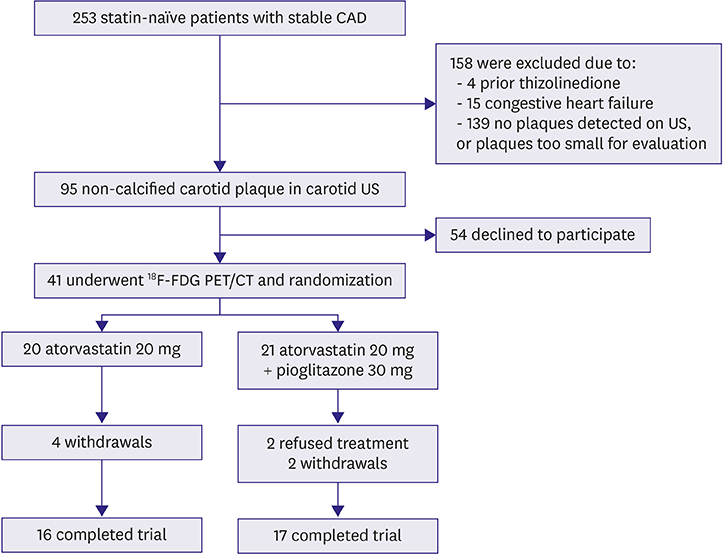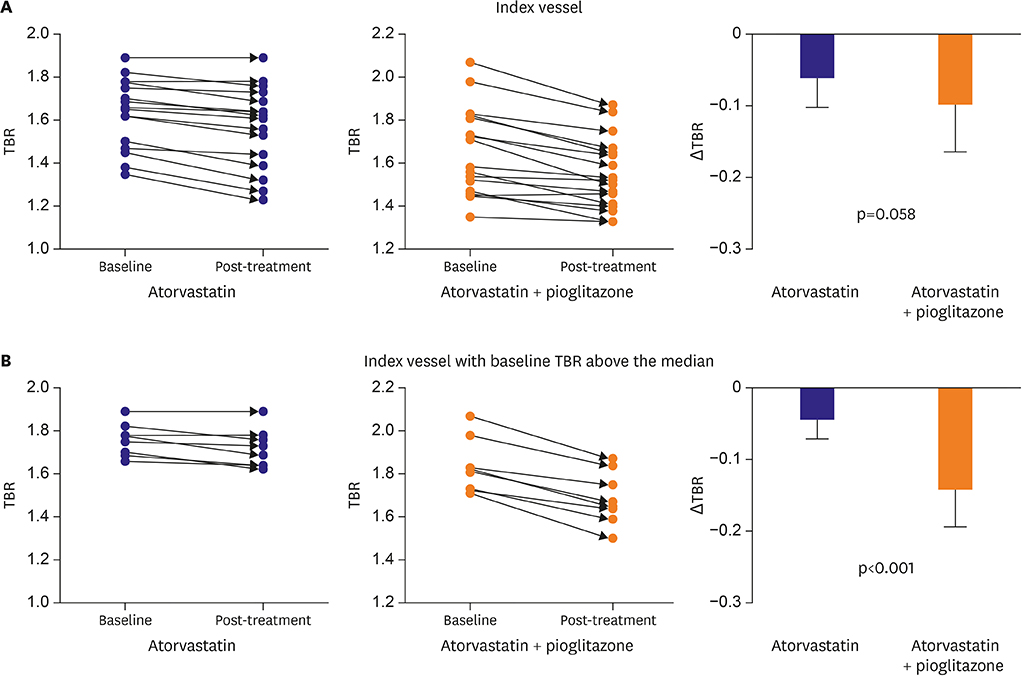Korean Circ J.
2018 Jul;48(7):591-601. 10.4070/kcj.2017.0029.
Effect of Pioglitazone in Combination with Moderate Dose Statin on Atherosclerotic Inflammation: Randomized Controlled Clinical Trial Using Serial FDG-PET/CT
- Affiliations
-
- 1Department of Cardiology, The Catholic University of Korea College of Medicine, Seoul, Korea. kbseung@catholic.ac.kr
- 2Department of Radiology, The Catholic University of Korea College of Medicine, Seoul, Korea.
- KMID: 2414893
- DOI: http://doi.org/10.4070/kcj.2017.0029
Abstract
- BACKGROUND AND OBJECTIVES
Non-statin therapy plus lower intensity statin might be an alternative in patients with coronary artery disease (CAD). A recent data suggested an anti-inflammatory therapy can reduce recurrent cardiovascular events and pioglitazone is also an intriguing inflammatory-modulating agent. However, limited data exist on whether pioglitazone on top of statins further attenuates plaque inflammation.
METHODS
Statin-naïve patients with stable CAD and carotid plaques of ≥3 mm were randomly prescribed moderate dose atorvastatin (20 mg/day), or moderate dose atorvastatin plus pioglitazone (30 mg/day) for 3 months. The primary endpoint was the change in the arterial inflammation of the carotid artery measured by 18F-fluorodeoxyglucose positron emission tomography/computed tomography (18F-FDG-PET/CT) during 3 months.
RESULTS
Of the 41 randomized patients, 33 underwent an evaluation by fluorodeoxyglucose positron emission tomography/computed tomography (FDG-PET/CT; 17 atorvastatin plus pioglitazone and 16 atorvastatin patients). The addition of pioglitazone significantly improved the insulin sensitivity and increased the high-density lipoprotein cholesterol after 3 months. Although a reduction in the (FDG) uptake by pioglitazone on top of atorvastatin in carotid arteries with plaque showed marginally statistical significance in the entire patient group (atorvastatin plus pioglitazone; −0.10±0.07 and atorvastatin −0.06±0.04, p=0.058), pioglitazone showed a further reduction of the fluorodeoxyglucose (FDG) uptake among patients who had a baseline FDG uptake above the median (atorvastatin plus pioglitazone; −0.14±0.04 and atorvastatin −0.03±0.03, p < 0.001).
CONCLUSIONS
Pioglitazone demonstrated marginally significant anti-inflammatory effects in addition to moderate dose atorvastatin. This may have been due to the lack of power of the study. However, pioglitazone may have an anti-inflammatory effect in those patients with high plaque inflammation (Trial registry at ClinicalTrials.gov, NCT01341730).
Keyword
MeSH Terms
-
Arteritis
Atherosclerosis
Atorvastatin Calcium
Carotid Arteries
Carotid Stenosis
Cholesterol
Coronary Artery Disease
Electrons
Humans
Hydroxymethylglutaryl-CoA Reductase Inhibitors*
Inflammation*
Insulin Resistance
Lipoproteins
PPAR gamma
Atorvastatin Calcium
Cholesterol
Hydroxymethylglutaryl-CoA Reductase Inhibitors
Lipoproteins
PPAR gamma
Figure
Cited by 1 articles
-
Effects of Combination Therapy of Statin and Thiazolidinedione on Vascular Inflammation
Ji-Yeon Lee, Bong-Soo Cha
Korean Circ J. 2018;48(7):602-604. doi: 10.4070/kcj.2018.0120.
Reference
-
1. LaRosa JC, Grundy SM, Waters DD, et al. Intensive lipid lowering with atorvastatin in patients with stable coronary disease. N Engl J Med. 2005; 352:1425–1435.
Article2. Pedersen TR, Faergeman O, Kastelein JJ, et al. High-dose atorvastatin vs usual-dose simvastatin for secondary prevention after myocardial infarction: the IDEAL study: a randomized controlled trial. JAMA. 2005; 294:2437–2445.3. Arnold SV, Kosiborod M, Tang F, et al. Patterns of statin initiation, intensification, and maximization among patients hospitalized with an acute myocardial infarction. Circulation. 2014; 129:1303–1309.
Article4. Preiss D, Seshasai SR, Welsh P, et al. Risk of incident diabetes with intensive-dose compared with moderate-dose statin therapy: a meta-analysis. JAMA. 2011; 305:2556–2564.5. Lloyd-Jones DM, Morris PB, Ballantyne CM, et al. 2016 ACC expert consensus decision pathway on the role of non-statin therapies for LDL-cholesterol lowering in the management of atherosclerotic cardiovascular disease risk: a report of the American College of Cardiology Task Force on Clinical Expert Consensus Documents. J Am Coll Cardiol. 2016; 68:92–125.6. Ridker PM, Everett BM, Thuren T, et al. Antiinflammatory therapy with canakinumab for atherosclerotic disease. N Engl J Med. 2017; 377:1119–1131.
Article7. Dormandy JA, Charbonnel B, Eckland DJ, et al. Secondary prevention of macrovascular events in patients with type 2 diabetes in the PROactive Study (PROspective pioglitAzone Clinical Trial In macroVascular Events): a randomised controlled trial. Lancet. 2005; 366:1279–1289.
Article8. Lincoff AM, Wolski K, Nicholls SJ, Nissen SE. Pioglitazone and risk of cardiovascular events in patients with type 2 diabetes mellitus: a meta-analysis of randomized trials. JAMA. 2007; 298:1180–1188.9. Kernan WN, Viscoli CM, Furie KL, et al. Pioglitazone after ischemic stroke or transient ischemic attack. N Engl J Med. 2016; 374:1321–1331.
Article10. Mazzone T, Meyer PM, Feinstein SB, et al. Effect of pioglitazone compared with glimepiride on carotid intima-media thickness in type 2 diabetes: a randomized trial. JAMA. 2006; 296:2572–2581.11. Saremi A, Schwenke DC, Buchanan TA, et al. Pioglitazone slows progression of atherosclerosis in prediabetes independent of changes in cardiovascular risk factors. Arterioscler Thromb Vasc Biol. 2013; 33:393–399.
Article12. Mizoguchi M, Tahara N, Tahara A, et al. Pioglitazone attenuates atherosclerotic plaque inflammation in patients with impaired glucose tolerance or diabetes a prospective, randomized, comparator-controlled study using serial FDG PET/CT imaging study of carotid artery and ascending aorta. JACC Cardiovasc Imaging. 2011; 4:1110–1118.13. Forst T, Wilhelm B, Pfutzner A, et al. Investigation of the vascular and pleiotropic effects of atorvastatin and pioglitazone in a population at high cardiovascular risk. Diab Vasc Dis Res. 2008; 5:298–303.
Article14. Hanefeld M, Marx N, Pfutzner A, et al. Anti-inflammatory effects of pioglitazone and/or simvastatin in high cardiovascular risk patients with elevated high sensitivity C-reactive protein: the PIOSTAT Study. J Am Coll Cardiol. 2007; 49:290–297.15. Fayad ZA, Mani V, Woodward M, et al. Safety and efficacy of dalcetrapib on atherosclerotic disease using novel non-invasive multimodality imaging (dal-PLAQUE): a randomised clinical trial. Lancet. 2011; 378:1547–1559.
Article16. Hwang BH, Kim MH, Chang K. Molecular imaging of high-risk atherosclerotic plaques: is it clinically translatable? Korean Circ J. 2011; 41:497–502.
Article17. Tawakol A, Fayad ZA, Mogg R, et al. Intensification of statin therapy results in a rapid reduction in atherosclerotic inflammation: results of a multicenter fluorodeoxyglucose-positron emission tomography/computed tomography feasibility study. J Am Coll Cardiol. 2013; 62:909–917.18. Pucci A, Formato L, Muscio M, et al. PPARgamma in coronary atherosclerosis: in vivo expression pattern and correlations with hyperlipidemic status and statin treatment. Atherosclerosis. 2011; 218:479–485.19. Thorp E, Kuriakose G, Shah YM, Gonzalez FJ, Tabas I. Pioglitazone increases macrophage apoptosis and plaque necrosis in advanced atherosclerotic lesions of nondiabetic low-density lipoprotein receptor-null mice. Circulation. 2007; 116:2182–2190.
Article20. Cocker MS, Mc Ardle B, Spence JD, et al. Imaging atherosclerosis with hybrid [18F]fluorodeoxyglucose positron emission tomography/computed tomography imaging: what Leonardo da Vinci could not see. J Nucl Cardiol. 2012; 19:1211–1225.
Article21. Rudd JH, Myers KS, Bansilal S, et al. Relationships among regional arterial inflammation, calcification, risk factors, and biomarkers: a prospective fluorodeoxyglucose positron-emission tomography/computed tomography imaging study. Circ Cardiovasc Imaging. 2009; 2:107–115.22. van der Valk FM, Verweij SL, Zwinderman KA, et al. Thresholds for arterial wall inflammation quantified by 18F-FDG PET imaging: implications for vascular interventional studies. JACC Cardiovasc Imaging. 2016; 9:1198–1207.23. Catapano AL, Graham I, De Backer G, et al. 2016 ESC/EAS guidelines for the management of dyslipidaemias. Eur Heart J. 2016; 37:2999–3058.
Article24. Ridker PM, Luscher TF. Anti-inflammatory therapies for cardiovascular disease. Eur Heart J. 2014; 35:1782–1791.
Article25. Erdmann E, Dormandy JA, Charbonnel B, et al. The effect of pioglitazone on recurrent myocardial infarction in 2,445 patients with type 2 diabetes and previous myocardial infarction: results from the PROactive (PROactive 05) Study. J Am Coll Cardiol. 2007; 49:1772–1780.26. Li AC, Brown KK, Silvestre MJ, Willson TM, Palinski W, Glass CK. Peroxisome proliferator-activated receptor gamma ligands inhibit development of atherosclerosis in LDL receptor-deficient mice. J Clin Invest. 2000; 106:523–531.27. Chang K, Francis SA, Aikawa E, et al. Pioglitazone suppresses inflammation in vivo in murine carotid atherosclerosis: novel detection by dual-target fluorescence molecular imaging. Arterioscler Thromb Vasc Biol. 2010; 30:1933–1939.28. Koh KK, Sakuma I, Shimada K, Hayashi T, Quon MJ. Combining potent statin therapy with other drugs to optimize simultaneous cardiovascular and metabolic benefits while minimizing adverse events. Korean Circ J. 2017; 47:432–439.
Article




